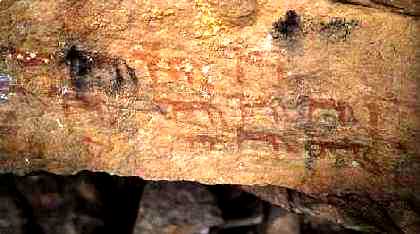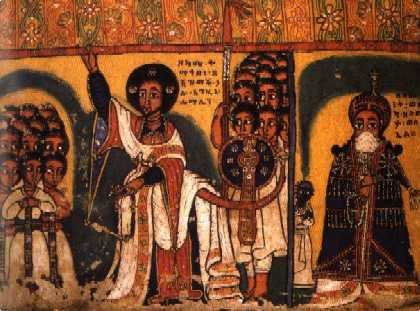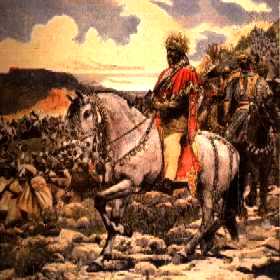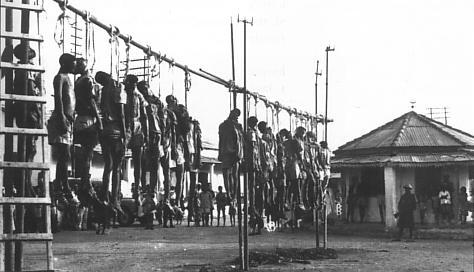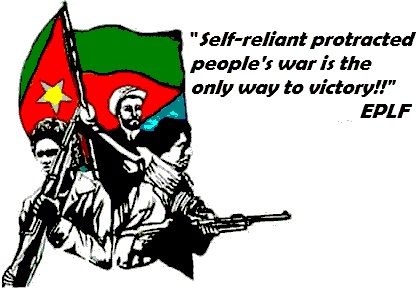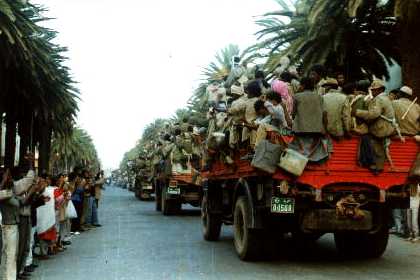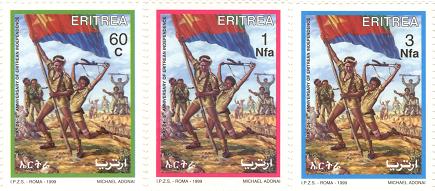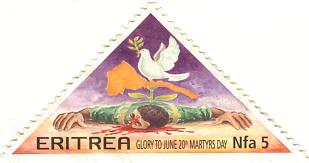Map of Eritrea
Location and geography
Eritrean history
Border conflict with Ethiopia
Political structure
Eritrean anthem
Economy & currency
Climate
People
Languages
Religion
Health care
Transport
Cuisine
News, links, books and more
Asmara (Asmera)
Agordat (Akordat)
Assab (Asseb)
Barentu
Dahlak islands
Dekemhare (Decemhare)
Ghinda (Ginda)
Keren (Cheren)
Massawa (Massauwa)
Mendefera (Adi Ugri)
Nakfa (Nacfa)
Semenawi Bahri (Filfil)
Tessenei
(Teseney)
History of Eritrea
Early history
Archaelogical evidence of pre-humans has been discovered in the Buya region of Eritrea, near Adi Keyh. The discovery may be one of the oldest ever found, and is similar to the famous "Lucy" find. Evidence of human presence begins in the 8th millennium B.C., beginning with Pygmoid, Nilotic, Cushitic (the Afar) and Semitic (Tigrinya) peoples. In the sixth century B.C., Arabs spread to the coast of present day Eritrea, in search of ivory and slaves for trade with Persia and India. Their language evolved into Ge'ez, related to today's Amhara, still spoken by Christian priests in Eritrea and Ethiopia.
Ancient rock paintings.
During the 3rd and 4th century AD, Eritrea was part of the kingdom of Axum which spread from Meroe in Sudan right across the Red Sea to Yemen. The capital of Axum was in the highlands of Tigray (now a province in Ethiopia), and the main port was at Adulis which is now called Zula in Eritrea. This Kingdom was based upon trade across the Red Sea and was founded by Semitic people originally from Arabia. Christianity was the predominant faith of Axum introduced through contact with traders throughout the region.
By the 6th century AD the Persian Empire expanded and with it went the expansion of Islam. In 710 AD Muslims destroyed Adulis and the ancient kingdom of Axum declined until it was reduced to a small Christian Enclave. For the next few centuries, the region settled into being a remote, isolated community only re-emerging by the early 16th century as Abyssinia. The Abyssinian Kingdom covered the Ethiopian highlands ruled by kings and peopled by Christian Tigrinyans and remaining fairly isolated. The community had little or no contact with the lowlands of the region which was home to predominantly Muslim communities.
This period in Eritrea's history is highly contentious. Ethiopians claimed Eritrea had been an integral part of historic Ethiopia but though there are some common practices and religious beliefs between Eritreans and Ethiopia, these ties do not extend throughout Ethiopia. In fact, large parts of Eritrea, it would seem, were linked to other empires. The Ottoman Empire and Egypt had relations with the northern and eastern part of the country, and various Sudanic Empires to the west and north-west have had their influence.
19th century expansionAbyssinia was subject to the expansionism of the Egyptians and some European powers (French, Italian and British). In the early parts of the century, Ali Pasha invaded Sudan and gradually pushed on the Western Lowlands of present-day Eritrea. By mid-century, European interest in the area was increasing. The British had a consulate in Massawa, and the French already had a presence. Italian missionaries were established in Keren.
Painting of Dejazmach Hailu, governor of Hamasien in the Asmara
region, armed with a long, sickle shaped sword, shotel. Dejazmach
Hailu held office during the reign of Emperor Tewodros II (1855-68).
Emperor Tewodros II, who ruled Abyssinia from 1855-68, also had to deal with rebel forces in Tigray and Shoa, who chose Ras Kassa as their ruler. Tewodros was defeated in 1868 after the British General Sir Robert Napier had landed in Zula to release the Consul and other prisoners held by the emperor. After Tewodros's defeat, Ras Kassa was crowned Emperor Yohannes IV in 1872. Yohannes's forces won a significant battle against the Egyptians at Gura in 1875. From this victory, Yohannes' foremost General, Ras Alula, became governor of the province of Hamasien and prince of Eritrea.
Italian influenceThe first Italian mission in Abyssinia was at Adua in 1840, under Father Giuseppe Sapeto. He was the vehicle through which the Italian government brought up pieces of land near Assab, initially on behalf of the national Rubattino Shipping Company. But as the European 'Scramble for Africa' gathered pace, the Italian government took over the land in 1882 and began to administer it directly. They also ousted the Egyptians from Massawa on the coast. However, expansion further inland soon led to clashes with Emperor Yohannes. In 1887, Ras Alula's forces inflicted a heavy defeat on the Italians at Dogali, forcing them to retreat.
This was a significant victory for Yohannes, who was also facing a number of other threats on different fronts at the same time - not only the Italians, but the Dervishes and Menelik, an increasingly disloyal general. Yohannes was eventually killed after being captured in battle against the Dervishes at Galabat. Following his death, Ras Alula withdrew to Tigray. This allowed Menelik to be named Yohannes successor in 1889 with substantial Italian backing, instead of the natural heir, Ras Mangasha.
Negus Menelik at the battle of Adua
(painting of Paul Buffet, 1898).
The Italians then moved rapidly, taking Keren in July 1889 and Asmara one month later. Melenik had signed the Treaty of Uccialli with the Italians the same year, detailing the areas each controlled. Just four years later, Melenik renounced the treaty over a dispute arising from further Italian expansionist attempts. After more military clashes and in the face of sizable Italian reinforcements, Melenik signed a peace treaty. Italy then began establishing colonial rule in the areas it controlled, as defined in the treaties with the Ethiopian emperor in 1900, 1902 and 1908.
Colonial ruleThe Italians initially used a system of indirect rule through local chiefs at the beginning of the 20th century. The first decade or so concentrated on expropriation of land from indigenous owners. The colonial power also embarked on the construction of the railway from Massawa to Asmara in 1909. Fascist rule in the 1920s and the spirit of 'Pax Italiana' gave a significant boost to the number of Italians in Eritrea, adding further to loss of land by the local population.
In 1935, Italy succeeded in over-running Abyssinia, and decreed that Eritrea, Italian Somali-land and Abyssinia were to be known as Italian East Africa. The development of regional transport links at this time round Asmara, Assab and Addis produced a rapid but short-lived economic boom.
However, there began to be clashes between Italian and British forces in 1940. Under General Platt, the British captured Agordat in 1941, Taking Keren and Asmara later that year. As Britain did not have the capacity to take over the full running of the territory, they left some Italian officials in place. One of the most significant changes under the British was the lifting of the color bar which the Italians had operated. Eritreans could now legally be employed as civil servants. In 1944, with the changing fortunes in world war II, Britain withdrew resources from Eritrea. The postwar years and economic recession led to comparatively high levels of urban unemployment and unrest.
Ethiopian ruleWhen the British withdrew, the fate of Eritrea was left in the balance. It was known that the British favored partition - the north and west of Eritrea to Sudan, The rest to Ethiopia, which suited Haile Selassie. After initial presentations on the possible future of Eritrea, in 1949 the UN established a Commission of Inquiry with the task of finding out what Eritreans wanted for their own future. For a number of reasons, countries represented on the Commission could not agree on recommendations. The eventual decision to federate Eritrea with Ethiopia in 1950 reflected the strategic interests of Western Powers, particularly the United States. The US Secretary of State, John Foster Dulles, put this succinctly in 1952:
'From the point of view of justice, the opinions of the Eritrean people must receive consideration. Nevertheless the strategic interests of the United States in the Red Sea basin and considerations of security and world peace make it necessary that the country has to be linked with our ally, Ethiopia.'
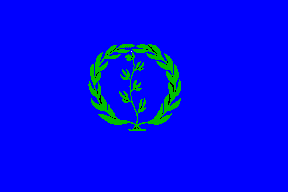
Eritrean Autonomous Region 1952-1962.
At the same time Ethiopia had been strengthening its ties with the United States, even sending troops to fight with the Americans in the Korean War in 1950. Concerned that a weak Eritrea might be vulnerable to a communist takeover, which would threaten access to the Red Sea and trade through the Suez Canal, the United States and other western powers, acting through the United Nations, promoted the idea of Eritrea becoming part of Ethiopia. In December 1952, the UN finally declared Eritrea an autonomous unit federated to Ethiopia and hence turned Eritrea over to its most brutal and oppressive ruler to date: Ethiopia. It was the beginning of the ten-year period of absoption by Ethiopia.
Haile Selassie saw to it that the first three governors of the federated unit were related to him. Ethiopia began to violate and undermine the federal arrangement. Eritrean political parties were banned. The agreed Eritrean share of customs and excise duty were expropriated. Eritrean newspapers were censored. In 1956, Tigrinya and Arabic were forbidden as teaching languages, and replaced with Amharic. Student protests and boycotts ensued, but were repressed. Eritrean industries were dismantled and moved to Addis Ababa. In 1962, with the silent consent of the UN and USA, and again against the expressed will of the people of Eritrea, Ethiopia unilaterally dissolved the "Federation", formally, forcefully and illegally annexed Eritrea and declared it to its 14th province of Ethiopia.
For the next 30 years, Eritrea's plight was virtually ignored by the international community. Frustration at the lack of room for political manoeuvre finally resulted in the launch of the armed struggle. Ethiopia's Haile Selassie was supported for decades by the United States for geopolitical and Cold War reasons. For the US's unrestricted use of a military base, Selassie was given "aid" (i.e. military aid). This unfortunately was used against Eritrean secessionists and Ethiopian guerillas in brutal wars.
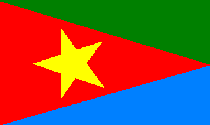
Flag of the EPLF freedom fighters
1961 - 1977 From guerrilla to an army
The armed struggle began in September 1961 when a contingent of eleven fighting men, under the leadership of Idris Hamid Awate formed the first armed forces of the Eritrean Liberation Front (ELF). By mid 1962 some 500 men were successfully harassing Ethiopian troops around Agordat. On December 19th 1962, a group of policemen deserted to the ELF in Massawa, taking with them rifles machineguns, and ammunition
In the first decade, attacks by ELF guerrillas were answered by Ethiopian reprisals, often directed against any civilian population. Ethiopian forces burned villages, sometimes massacring hundreds of villagers. Waves of refugees began to pour into Sudan. As a result the sympathy that might once have existed among some sectors of the population for a close relationship with Ethiopia rapidly disappeared.
Ethiopian forces tried to weaken the morale of the population of Eritrea by hanging
captured ELF freedom fighters and civil collaborators in the center of Eritrean villages.
The period 1970 to 1974, when the ELF and the newly-emerged EPLF fought a civil war, is a bleak period in Eritrea's history. This ended when the revolution in Ethiopia made it imperative for the fronts to hold a common position to confront any proposals that might come from Addis. By this time the EPLF was establishing itself as a powerful force. During 1974/75 it further strengthened itself by successfully recruiting Eritreans with military training from the Ethiopian police force in Eritrea, and from Eritrean commando units which it had successfully defeated. A large influx of young people joined the EPLF after 56 students were garroted with electric cable in Asmara in January 1975.
By mid 1976, began the launching of the 'Peasant Army' offensive against Eritrea. The Eritrean guerrilla forces (estimated to number 20,000) managed to win considerable victories against the occupying Ethiopians. The EPLF laid siege to Nacfa in September 1976. In 1977 they took Karora, Afabet, Elaberet, Keren and Decemhare. They also surrounded Asmara, Eritrea's capital and organized the escape of 1,000 political prisoners from Asmara's jail.The ELF took Tessenei, Agordat and Mendefera. By the end of 1977 the mainland Massawa was in the hands of the EPLF, which now had captured tanks and armored vehicles. They were close to final victory in early 1978, but had not planned on the Soviet Union's crucial intervention in the form of military aid for Mengistu's regime in Ethiopia.
1977 - 1988 Soviet intervention
The Soviet Union intervened in December 1977. The Soviet navy, by shelling EPLF positions from their battleships, prevented the EPLF from taking the port section of Massawa. A massive airlift of Soviet tanks and other arms allowed the Ethiopian army to push back the Somali forces in the Ogaden, and by May/June 1978 these troops and heavy Armour were available for redeployment in Eritrea. In two offensives the Ethiopian army retook most of the towns held by the Eritrean fronts.
For the EPLF the return to the northern base areas was 'a strategic withdrawal'. It minimized civilian and military casualties. It also allowed the EPLF to give battle at strategic points of its choosing, to evacuate towns and to remove plant and equipment to its base area.
For the ELF the story was different. In attempting to hold territory its casualties were high. The balance of military power between the fronts had now shifted strongly towards the EPLF. Recognizing its weaker position, worsened by ethnic disputes, the ELF began in 1979 to respond to the Soviet proposals. In return for its agreement to autonomy within Ethiopia the ELF was offered the reins of government in Eritrea, while the EPLF stood for a secular and socialist state of Eritrea, rejecting ethnic differences.
A bitter civil war between the ELF and the EPLF resulted, that the EPLF finally won in 1981. ELF fighters either changed sides or fled to Sudan, and the EPLF became the single front with a military presence in Eritrea. The EPLF successfully resisted offensives in 1982 and 1983, while the Dergue organized genocidal responses to eliminate the broad civil support to EPLF liberation movement. But the EPLF lines held and the morale and confidence of the EPLF were given massive boost while the Ethiopian army was demoralized. Its net effect was to strengthen the range of military equipment at the EPLF's disposal.
Through most of the war, Ethiopia occupied the southern part of Eritrea. The EPLF had to settle in the inhospitable northern hills towards the Sudanese border. These hills became a safe haven for the families of soldiers and the orphans and disabled. Consequently, much of the regions around Afabet and Nacfa in Sahel province became home to makeshift homes, schools, orphanages, hospitals, factories, printers, bakeries etc. in an attempt to live life as normally as possible under extraordinary conditions. Most structures were built either into the ground or in caves to avoid being bombed by Ethiopian jets. The steep narrow areas were chosen as they were the hardest for the jets to negotiate.
In 1984, while Mengistu was spending lavishly on a celebration of the tenth anniversary of his glorious revolution, one-sixth of the population of Ethiopia was in danger of dying of starvation, and ten thousand people per week were already dying. As part of the "politics of famine", Mengistu began using his power to block delivery of grain to areas he considered hostile to him, most notably Tigray and Eritrea. Innocent people starved to death while grain sat undelivered.
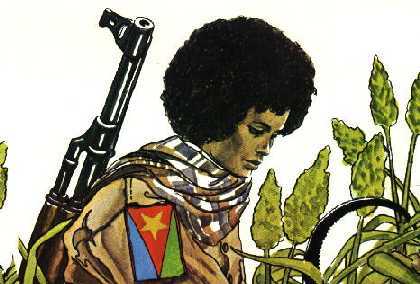
Eritrean women played a central role in liberating the nation.
1988 - 1993 The victoryAt the end of the 1980s, the Soviet Union informed Mengistu that it would not be renewing its defense and cooperation agreement with Ethiopia. With the withdrawal of Soviet support and supplies, the Ethiopian Army's morale plummeted and the EPLF began to advance on Ethiopian positions. In 1988, the EPLF captured Afabet, headquarters of the Ethiopian Army in northeastern Eritrea, prompting the Ethiopian Army to withdraw from its garrisons in Eritrea's western lowlands. EPLF fighters then moved into position around Keren, Eritrea's second largest city.
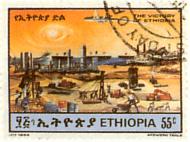
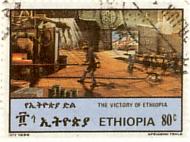
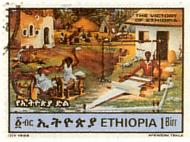
Series of stamps issued in 1988 on the occasion of the
"victory" of Ethiopia. In the
the same year the Ethiopian army suffered heavy losses on the EPLF and the
TPLF!
The EPLA (military branch of the EPLF) by this time includes twelve infantry brigades (some 20,000 fighters), 200 tanks and armored vehicles, and a fleet of fast attack speedboats, all captured in battle and in guerrilla raids from the Ethiopians. EPLA's disadvantageous combat ratio ranged from 1:4 to 1:8, but the battlefield mortality ratio was at least ten Ethiopians to one Eritrean, due to better trained and more committed fighters.
In 1990 the EPLF had captured the strategically important port of Massawa, and they entered Asmara, now the capital of Eritrea, in 1991. The Ethiopian army under Haile Mariam Mengistu (an army officer who deposed Haile Selassie in 1974) intensified the war against Eritrea, but it was easily defeated in 1991 after Mengistu fell from power.
It was at 10:00 a.m. on May 24, 1991 that Asmara residents realized EPLF fighters had entered their city. In a spontaneous outburst of happiness and relief, Asmarinos flung open their doors and rushed into the streets to dance in jubilation, some still in their pajamas. The dancing lasted for weeks.
On May 24th 1991, after thirty years of relentless struggle, the
EPLF entered Asmara to a universal and delirious welcome.
At a conference held in London in 1991 the Ethiopian People's Revolutionary Democratic Front (EPRDF), who were now in control of Ethiopia having ousted Mengistu and were sympathetic to Eritrean nationalist aspirations, accepted the EPLF as the provisional government of Eritrea. So began the long process towards independence and international legitimation of Eritrea as a country in its own right.
In April 1993 a referendum was held in which 1,102,410 Eritreans voted; 99.8% endorsed national independence and on May 28 Eritrea became the 182nd member of the UN. Later that year, Eritreans elected their first president, Isaias Afewerki, formerly secretary-general of the EPLF.
Thus it is now eligible to receive international aid to help reconstruct and develop its shattered economy. Since establishing a provisional government in 1991, Eritrea has been a stable and peaceful political entity, with all political groups represented in the transitional government.
The war has had a devastating effect on Eritrea. Around 60,000 people lost their lives, there are an estimated 50,000 children with no parents and 60,000 people who have been left handicapped. However, there is now great optimism with people pulling together to rebuild the country. The National Service, announced on July 14th 1994, required all women and men over eighteen to undergo six months of military training and a year of work on national reconstruction. This helped to compensate for the country's lack of capital and to reduce dependence on foreign aid, while welding together the diverse society.
Series of stamps issued on the occasion of May 24th 1999
celebration of the eight anniversary of Eritrean Independence1997 The border conflict
Following Eritrea's independence in 1993, a boundary commission had been established to cover the Yirga Triangle (Badme) and other disputed areas. In 1997, the Ethiopian authorities issued a map of the Tigrayan Administrative Region which confirmed Tigrayan expansionism. The map proved to be the end of the good relations between Eritrea and Ethiopia, and resulted in an armed conflict in August 1997 and an all-out war in May 2000, when Ethiopia occupied large parts of Eritrea. An estimated 1.1 million Eritreans have been displaced by Ethiopian aggression and an estimated 100.000 Ethiopian and 20.000 Eritrean soldiers were killed in this two year war.
On June 19th 2000 both parties agreed on a ceasefire and on December 12th 2000 a peace agreement was signed in Algiers. A 4200-strong multinational UN peacekeeping force (UNMEE) was deployed for the de-mining and demarcation of the border.
On April 13th 2002 the Permanent Court of Arbitration in The Hague published the conclusions of the Eritrea-Ethiopia Boundary Commission. The lands bordering the Yirga Triangle, areas, including Badme in the Central zone and Eastern Sector and border town Tserona have been awarded to Eritrea. The border towns Zalambessa and Alitena (Central Sector) and Bure (Danakil Depression) were awarded to Ethiopia.
Background to the border conflict > > >
Review map of the decisions of the EEBC > > >
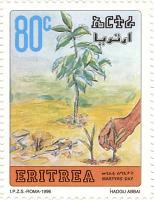
Stamp issued by the Eritrean Postal Services on the occasion of Martyr's Day June 20th 1996. 6 million plants were planted and are being tended all over Eritrea by all the Eritrean society in every local area of the country.
Every Martyrs Park is a memorial, to honor and remember the victims of the fight for Eritrean independence.
| Celebration of historical events in Eritrea | |
| Fenkil (liberation of Massawa 1990) | February 10 |
| Liberation Day (1991) | May 24 |
| Martyr's Day | June 20 |
| Start of Armed Struggle (1961) | September 1 |
|
Stamp issued by the Eritrean Postal
Services |
|
| Eritrean Armed Struggle Landmarks | ||
| 1961 | September 1 | Launching of armed struggle |
| 1963 | October | Operation Haikota |
| 1964 | March 15 | Major ELF offensive against enemy forces |
| 1975 | February 1 | Large scale offensive against enemy forces around Asmara, Freeing of political prisoners from Adi Quala prison by the ELF |
| 1976 | May 21 | Enemy offensive under so-called Raza Project, which involved a peasant force comprising 30-40 men repulsed |
| 1977 | January 7 | Liberation of Karora |
| 1977 | March 23 | Liberation of Nacfa |
| 1977 | July 6 | Liberation of Dekemhare |
| 1977 | July 15 | Operation Sembel, Freeing by the EPLF of 800 political prisoners |
| 1977 | September | Capyure, for the first time, of 100mm T-55 enemy artillery around Ademzemat |
| 1978 | July - August | Battle of Adi Yakob, Strategic retreat from Northern Front |
| 1978 | November | Second enemy offensive |
| 1979 | January - February | Third enemy offensive |
| 1979 | April 1 | Forth enemy offensive |
| 1979 | July 14-26 | Fifth enemy offensife |
| 1979 | December 2-16 | First counter offensive in Nacfa |
| 1982 | February 15 - June | Sixth enemy offensive (Red Star Campaign) lasting 95 days |
| 1983 | March 26 | Seventh enemy offensive (Selahta) |
| 1984 | January 15 | EPLF counter offensive in Tessenei |
| 1984 | March 19-21 | Demolishing if enemy Wikaw Command, i.e. the enemy's front in north-eastern Sahel |
| 1984 | April 27 | Tank battle against enemy forces along Nacfa front |
| 1984 | May 21 | First commando operation in Sembel, Asmara, in which a total of 33 enemy aircraft, 16 of them MIG fighters were destroyed |
| 1985 | July 6 | Liberation of Barentu, strategic retreat from the town after heavy enemy troop reinforcement |
| 1985 | October 10 | Eight enemy offensive (Bahri Negash) |
| 1988 | March 17-19 | Demolishing of Naddow IZ and liberation of Afabet |
| 1989 | February 17 | Joint operation of EPLF Commandoes and Afar Liberation Front revolutionary in Dubti along the Assab-Addis Ababa road |
| 1990 | February 10 | Operation Fenkil, liberation of Massawa |
| 1991 | May 19-21 | Demolishing of enemy front around Dekemhare |
| 1991 | May 24 | Total liberation of Eritrea |
|
||
